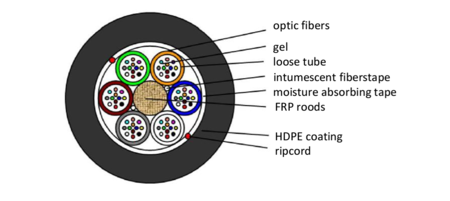Product Details
Underground and duct fiber optic cables are outdoor network cables designed to be laid directly in the ground or in tele-technical ducts.
FCA
Z-XOTKtsd-CC2 2x12 2D 24J LS
TP036642
Z-XOTKtsd-CC2 2x12 2D 24J LS
New
Similar Products
Product Description
The 24FO (2X12) Duct Central Tube Fiber Optic Cable OS2 G.652.D HDPE Anti Rodent Black (Part number: Z-XOTKtsd-CC2 2x12 2D 24J LS) from FCA with 24FO and Anti Rodent construction. Conduit cables are underground cables, that may be conducted by duct or buried directly into the ground. There are several types of protections for this cable such as anti-rodent or double protection. Conduit cables are built to withstand harsh environments and are typically routed by pull or blow.
Fiber optic underground and duct cables are outdoor network cables designed to be laid directly in the ground or in tele-technical ducts. The cable sheath insulates the fibers inside, providing permanent protection against the damaging effects of climatic and mechanical factors such as increased temperature, crushing or flooding with water. The cable tubes are twisted around a central strength element, namely glass fiber, reinforced with two FRP rods. This reduces the risk of loss of transmission continuity and damage to the network, and the need for repair decreases as much as possible.
Application
- blowing, pulling
Characteristics
- FRP glass fiber central strength element, fully dielectric cable, fiber color compliant to IEC 60304, singlemode 9/125µm fibers in G.652D standard, designed for air-blown installation, water ingress protection layer, low friction outer sheath, outer sheath made of HDPE
Product Specifications
Fiber Type (ITU) - OS2 G.652.D
Each type of single-mode fiber has its own area of application, and the evolution of these optical fiber specifications reflects the evolution of transmission system technology from the earliest installation of single-mode optical fiber to the present day. Choose the right fiber is very important for each project/installation. The specification of the OS2 fiber is generally considered as the SMF standard for the single-mode fiber. For the OS2 G.652 fiber there are 4 subcategories: G.652.A, G.652.B, G.652.C, G.652.D.
The OS2 G.652.D single-mode fibers are the most used type of fiber for networking and communications applications. The OS2 G.652.D fiber type provides a zero dispersion at 1310nm wavelength therefor it is optimized for operation in the 1310nm Wavelength. The regular performance remains on the 1550nm wavelength.
Benefits of using the OS2 G.652.D fibers:
- Backward compatibility with earlier versions;
- Lower system cost;
- Offers zero water peak and seamless splicing;
- Lower splicing losses;
- Supports longer cable runs.
FOC Protection - Anti Rodent
Anti-Rodent is a type of fiber optic cable protection designed to prevent damage from rodents such as rats, mice, and squirrels. This protection is achieved by applying a special coating or tape to the cable, making it difficult for rodents to chew through the cable and cause damage. Anti-rodent protection is particularly important in outdoor and underground installations where rodents are common, and can help to prevent costly and time-consuming repairs.
Jacket Material - HDPE
HDPE (high-density polyethylene) is a jacket material that offers excellent protection against moisture, chemicals, and abrasion. It is highly resistant to impact, making it ideal for rugged applications where cables are exposed to rough handling. HDPE is also UV-resistant, and it can withstand extreme temperatures, making it a good choice for outdoor and industrial environments. However, it is less flexible than other materials, which may make it difficult to use in certain applications.





.png?locale=en)



















